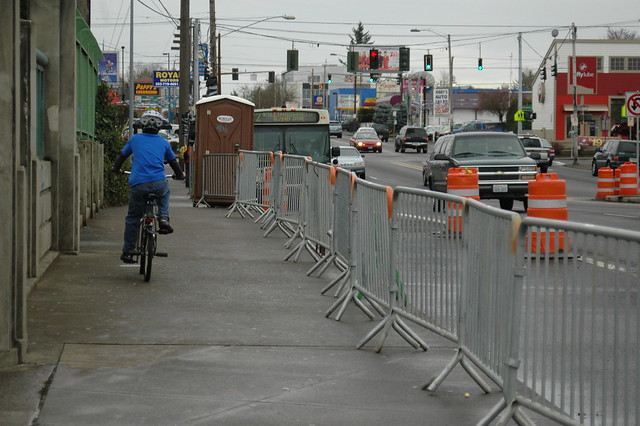
(Photo: Elly Blue)
As Oregon creates its first-ever comprehensive biking and walking wishlist, it’s run into a hard question: how should it rank the importance of the many projects on its list?
The question comes three years after a round of ODOT’s federal grant applications for Portland-area biking and walking projects came up completely empty. As the next federal grant deadline approaches, ODOT is hoping that by creating a more sophisticated system to choose its top projects — a complete sidewalk along 82nd Avenue, maybe, or a crosswalk beacon on North Lombard street — it won’t miss out on the next round of federal grants.
Applications for the next grant cycle, which will fund projects in the years 2018-2021, are due this August.
“I think this is going to bring active transportation on par with our other systems,” ODOT Active Transportation Liaison Jessica Horning said Thursday. “We’ve had a pavement management system in place for years.”
Advertisement
Horning and project manager Karla Kingsley of Kittelson and Associates presented their work so far at the Portland Bureau of Transportation’s free “lunch and learn” seminar at City Hall on Thursday. They shared a list of considerations used by a similar project in Washington County:
And a second list, of the seven criteria that have tentatively been selected by ODOT’s committees as the most important:
But ODOT hasn’t yet figured out how to weigh those factors against each other, or whether other factors deserve top billing too. Next month the agency plans to hold an online “virtual open house” to ask for advice on how to do so. To sign up for email updates, contact Horning: jessica.horning@odot.state.or.us.
Though the new priorities database applies only to the Portland area, known within ODOT as Region 1, Horning said the system is being designed as a template for the rest of the state.
“It’s going to be the first time that we have a holistic picture of what our needs are and how they stack up,” Horning said. “It’s an exciting pilot project.”


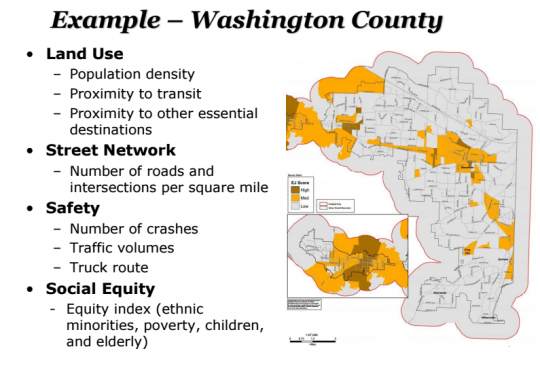
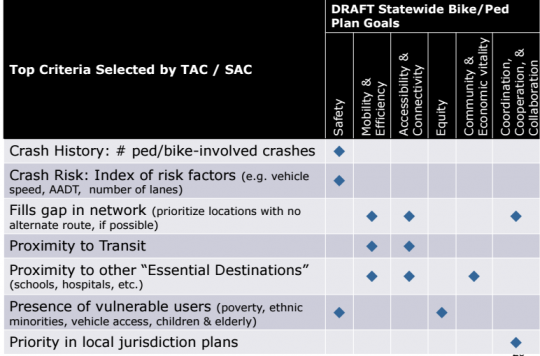
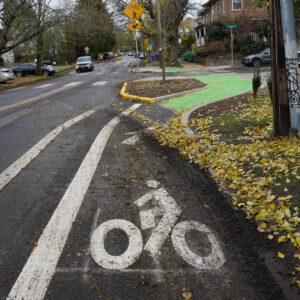
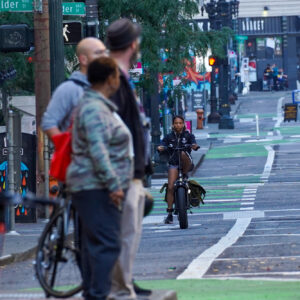

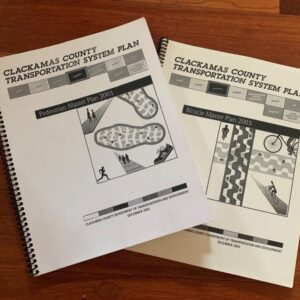
Thanks for reading.
BikePortland has served this community with independent community journalism since 2005. We rely on subscriptions from readers like you to survive. Your financial support is vital in keeping this valuable resource alive and well.
Please subscribe today to strengthen and expand our work.
BARBUR
Barbur? What about it?
See in my earlier posted comment, that a big issue confronting ODOT, is that it has to be able to get the money to do projects, and have the justification to do them. In the case this bikeportland story reports on, the money ODOT is trying to get, is money from the federal government. Awarded after consideration of all state’s proposals for projects they want help with. In theory, the money will go to fund projects in which the need most justifies the expenditure.
The section of Barbur we have been pushing on is a short stretch of re-striping. The coast is minimal….MUCH less than even one traffic light. The issue is one of politics…that is all.
“…The section of Barbur we have been pushing on is a short stretch of re-striping. …” Terry D-M
You’re not being clear about what section you’re referring to, but if you’re referring to a reconfiguration of Barbur for a road diet across two of the roads bridges, what you say is not true. The reconfiguration involves something far more dramatic than restriping, which would be to eliminate one of the two north bound lanes to create a continuation of the bike lanes across the road.
If a proposal to do this would be a request ODOT were to put on its grant application to the federal government for biking and walking projects, do you think this proposa would help to successfully gain the award over other state’s project requests?
And lets spell out the politics: Portland votes are seen as a sure thing while Tigard/Tualitin votes are not. Anything that triggers the “war on cars” wedge issue has been a hot potato for our recent run of center-right governors.
Outer Powell Blvd. #1 high crash intersection in the state at 122nd & Powell.
I don’t mean this to be at all callous, and I think I understand what they are getting at, but I don’t agree with the trend toward prioritizing by social equity / presence of vulnerable users (as defined as poverty and ethnic minorities). People walking and biking are people, no matter their income or ethnicity. I would rather just say, this area has a lot of people living with sub-standard infrastructure, let’s prioritize it. It seems to me that prioritizing by social equity is a social inequity in itself.
Or just quit funding the auto-only stuff.
Then we’d have so much money (in bike infrastructure terms) we could do everything we ever dreamt of in one year!
Doesn’t Portland have a complete streets policy? Not sure if ODOT does or not.
In the past most of the infrastructure went to the well connected, well off neighborhoods. Why do you think the infrastructure is so much poorer in the lower income regions? Hence social equity…poor people need safe walking and biking conditions more than those who drive their new cars to the closest expressway.
“In the past most of the infrastructure went to the well connected, well off neighborhoods.”
I think the issue is more complex than that. Did the investments go to the well off neighborhoods, or did the well off go to the areas with good infrastructure? North Portland is an example of a low-income neighborhood that recently underwent a large investment in improvements and, as a result, the demographics are changing.
There’s also the issue of annexation. Much of the worst infrastructure (and poorest neighborhoods) are in outer east Portland, which were not annexed into the city until the 1980’s and 90’s. Essentially, Portland inherited that sub-standard infrastructure and it takes time and money to bring them up to current standards.
“Poor people need safe walking and biking conditions more than those who [can afford to] drive their new cars to the closest expressway.”
I disagree. Everyone deserves safe walking and biking conditions, regardless of income or ethnicity.
My point isn’t that low income neighborhoods shouldn’t get investments in safe infrastructure. I recognize many of those areas need work and I am in favor of those investments. I just don’t believe income or ethnicity is the right metric to prioritize it. If you have two identical neighborhoods with the same infrastructure, except one is predominately white and the other is predominately minority, how do you say one deserves more investment than the other?
“Essentially, Portland inherited that sub-standard infrastructure and it takes time and money to bring them up to current standards.”
Time and money, but also (most importantly) WILL to bring them up to standards.
I’m actually interested in PBOT balancing (or maybe skewing) the money by area (whether that be individual neighborhoods, but probably not quadrants).
I’m with you, we should be bringing up every area to the same level, regardless of where it is or who lives there. Just so happens to be that the areas that need the most work in this city are predominantly lower income and house much of the cities minority populations.
But Jeff makes a good point. Take a comparatively rundown neighborhood and start spending money in it, such as improving its walking/biking infrastructure and other things generally associated with improved “livability”, and people start moving there. Rents and housing prices go up, in turn encouraging more “gentrification.” This is particularly the case in close-in neighborhoods and we’re surrounded with examples here, like around the Williams corridor. Within a few years it becomes an upscale neighborhood. It seems to me targeting poorer neighborhoods for such improvements for social equity reasons has sort of a perverse result along these lines, unless you incorporate rent control or some other kind of price governor at the same time. Not taking a position on this yet either way, just noting the point made.
I think Jeff’s point is more about bringing areas up to having sidewalks at all. I don’t know that much of east Portland is going to all of a sudden start gentrifying because the city builds sidewalks out there. Most of the areas that we would currently classify as gentrifying have long had the basic infrastructure (paved streets and sidewalks). They’re hot now more because they’re closer to downtown or the inner east side than because they have sidewalks.
While I think the equity issue is real, and parts of PBOT does a lot to focus resources where they have not gone in the past, I think there is a bigger picture being missed.
Much of the yardstick to measure ROI is based on delay to autos/congestion. Yes, historic crashes are considered, but not a more important metric, risk.
Congestion is based on LOS, not efficiency – persons per hour.
Safety is based on history, not the future and now. The difference is as clear as Washington and Oregon and median cable barrier.
Viewing improvements through a risk lens would elevate pedestrian and cyclist projects (vulnerable roadway users) above those occupants of 3,000 pound steel cages with internal crash attenuation features.
This is a key tenent of Safe Systems/Vision Zero – minimize risk of a fatal outcome first, then consider mobility.
Regularly scheduled sweeping!
My wish is that ODOT gets out of the way completely and transfers all rights and responsibilities of important community streets to the city. I don’t trust ODOT to implement a bike or ped improvement. Their engineers prioritize auto traffic over all else, so why bother? It’ll be half-assed.
“It’ll be half-assed.”
I hold the same dim view of their efforts, but what if we turn this around and ask What was the Very Best ODOT has done in terms of bike infrastructure, bike accommodations? The Apex.
Anyone?
:crickets:
I agree regarding orphan highway transfer. The insistence of cities that improvements or the funding to make them comes with the transfer only delays the short-term quick fixes that could be saving lives.
“My wish…” Jayson
Re-read this bikeportland story. It explains to those of us reading it, that ODOT is asking the federal government for money to fund various biking and walking projects. That is, bike and pedestrian traffic projects, rather than “…auto traffic…” projects.
ODOT of course, does have to prioritize construction and maintenance of roads for use with motor vehicles, because that type vehicle is how the vast majority of road users get around, and it’s by that means that the majority of goods and services are provided. The economy relies critically on the roads being viable for use with motor vehicles, rather than bikes.
Despite this, as the central point raised by this bikeportland story states clearly, Oregon’s transportation dept, is reported to be focused on making efforts to meet federal government criteria that will allow Oregon to receive money specifically for biking and walking projects.
“ODOT of course, does have to prioritize construction and maintenance of roads for use with motor vehicles, because that type vehicle is how the vast majority of road users get around, and it’s by that means that the majority of goods and services are provided. The economy relies critically on the roads being viable for use with motor vehicles, rather than bikes.”
That would be a familiar, unsurprising, and perhaps pragmatic way of thinking about how ODOT spends our money. But it is far from the only way, and the fact that ODOT occasionally makes noises such as above, suggests that even some at ODOT recognize that it isn’t perhaps the only much less best way to think about this.
If San Luis Obispo (see this week’s Monday Roundup) can take a prospective view of this question, why can’t we? They seem to have grasped the dynamic, get-out-in-front-of-this, build-it-and-they-will-come, dimension of infrastructure prioritization, rather than what we seem to be saddled with here with ODOT.
The city created a policy that allocates general fund transportation spending by mode to match the mode share percentage goals desired.
http://www.bikewalkalliance.org/blog/535-how-san-luis-obispo-just-established-the-most-powerful-bike-funding-policy-in-the-nation
“The economy relies critically on the roads being viable” — getting more users out of single-occupancy vehicles for commutes and short trips will do that very efficiently.
” “The economy relies critically on the roads being viable” — getting more users out of single-occupancy vehicles for commutes and short trips will do that very efficiently.” Eric
Explain how it is you believe that getting more road users out of their cars will very efficiently sustain road viability that’s critically needed for the health of the economy.
ODOT rebuilt part of the Iowa Street trail under I-5 and Barbur.
“…The question comes three years after a round of ODOT’s federal grant applications for Portland-area biking and walking projects came up completely empty. …” andersen/bikeportland
It’s Fed money, and ODOT wasn’t successful in seeking to get it, last time around. It’s difficult to make improvements to infrastructure when the money to make them isn’t available. So what ideas and objectives for which road infrastructure examples in Oregon in need of improvement, does ODOT’s grant application need to propose in order to get the money from the Feds? So those improvements can be made.
I like what I think the considerations and criteria tools posted in the story above, may do to help ODOT and members of the community, decide what road infrastructure situations may make good projects for improvement that the federal government feels it can rightly award money to.
Aside from the established point made here at bikeportland, that some people favoring bikes for transportation, would like equipped with continuous bike lanes and sidewalks, roads such as Barbur Blvd, that see very heavy use with motor vehicles: is this type project on that type road, proposed in the grant application, likely to win the money?
“is this type project on that type road, proposed in the grant application, likely to win the money?”
Well to that I’d say, if it isn’t, then it’s up to ODOT to make that pitch, convince the Feds that they should see it that way. Just imagine how differently some of us would feel about ODOT if, for once, they got out ahead of this debacle and stumped for the right thing.
The charts and maps above all look promising—or at least like ODOT spent a bunch of staff time developing all these metrics and decision rules—but the proof is in the pudding, right? If stuff gets built, I’ll happily take back my pessimistic views.
A pedestrian / bike bridge is needed from SW 52nd Ave (near Dickinson Park) to the Markham school on SW Capitol Highway. It would go over I-5 and have a connection to SW Barbur Blvd.
Many nearby roads in that area of SW have gravel roads, weeds that block unbuilt public right-of-way, no shoulders, and no street lights.
A) Federal funding rarely, if ever, goes toward local streets. The freeway is the only nexus to the Federal system that might win points for funding.
B)PPS doesn’t like to encourage the general public to regularly walk through their property. PBOT has several locations identified that would provide a short cut for a greenway, except that it would be on school property, and that is a non-starter with PPS.
C) Right of Way – Luradel has a connection to the I-5 corridor and the 48th drive right of way also abuts I-5. Otherwise air rights easments or real estate purchases tack on to the $1M-$2M just for the bridge.
Fix crash corner in Raleigh Hills by Parr Lumber.
That intersection is begging for a giant traffic circle.
More like a pair of hybrid 2+1 modern roundabouts.
An earlier version of this story had a graphic that showed “actual” and “goal” of sidewalks along ODOT facilities. Incredibly, the goal was showing a decline after 2012, if I remember correctly. I don’t understand why sidewalks along ALL urban arterials under ODOT jurisdiction is not the goal. Maybe the graphic was too embarrassing and was replaced with a photo.
I clicked on the link and got to an ODOT site that really didn’t say anything. What’s with the editing?
Yes, here’s the chart that was at the top of this post when we first published:
http://bikeportland.org/wp-content/uploads/2015/02/declining-bike-lanes1.png
The problem with that chart was that it had too little context to be useful. The reason the ratio of state routes with bike lanes and sidewalks was declining, despite ongoing sidewalk and bike lane infill, was that state highways with complete facilities was continuing to be handed over to cities.
Certainly it’s not a good thing that barely more than 40 percent of ODOT roads have sidewalks and bike lanes. But the reason the chart was in the presentation in the first place was that Horning was using it as an example of a bad way to assess the agency’s progress. I wasn’t at the presentation yet when she shared that slide, so I missed the context.
It’s not that the chart is useless, but this post isn’t about jurisdictional transfers, so the chart wasn’t the right way to frame this story.
Anyway, good question and sorry about the confusion. My bad.
She made the point that it is better to create a time line chart where BOTH variables do not change over time….as it is deceptive.
ODOT has a pavement management division? Maybe they could be a little more vocal about the unfunded damage from studded tires, there is barely a peep from them about this issue.
I’m surprised ODOT is even talking about active transportation. Given the current state of the roads that ODOT controls, I’m surprised it’s even in their vocabulary. The majority of them are shoulder-less, sidewalk-less, freeways being passed off as surface roads. I agree that they should pass off all region 1 responsibility to the city, and I hope they’re reading this.
“I’m surprised it’s even in their vocabulary.”
Well, at this point we’re only talking about words, not deeds. The words active transportation are fairly cheap. Though not as cheap as the words CRC by a long shot.
“…I agree that they should pass off all region 1 responsibility to the city, and I hope they’re reading this.” Scott H
Would the city and Portland residents want or be willing to take on the responsibility and expense of maintaining state roads within in ODOT region 1?. And if they did take on the responsibility, how would they manage to pay for it, considering the huge problem Portland is having in maintaining the streets the city already has responsibility for.
ODOT doing the work on certain roads in Portland means that not just Portland taxpayers, but resident taxpayers across the entire state are paying for that work.
82nd is the most depressing street I can think of. The hopelessness of this street is just crushing.
Lots of sidewalk and bike lane gaps on 99W, not to mention crosswalks missing across 99W in several locations (only appear on one side of the intersection).
Also, fill the sidewalk gaps on Hall Blvd, and the missing bike lane on Upper Boones Ferry between Durham Rd and 72nd (north of Durham Rd).
The slides and audio for this presentation are available online. Click my name to go to the page. (5 mb .pdf and 100 mb .wav files)